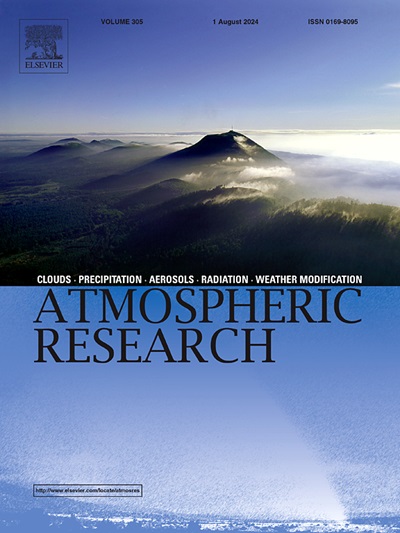Revisiting spatio-temporal variation in compound dry-hot extreme events in China with newly developed nonstationary index
IF 4.5
2区 地球科学
Q1 METEOROLOGY & ATMOSPHERIC SCIENCES
引用次数: 0
Abstract
Compound dry-hot extreme events (CDHEs), as the most typical compound extreme events, bring more harm to human society than single extreme events. Traditional indicators based on stationary assumptions of hydrometeorological variables for CDHEs detection may no longer be valid due to anthropogenic and climate change impacts. The nonstationary hydrometeorological series has been extensively studied but rarely considered in identifying CDHEs. Therefore, this paper develops a nonstationary compound dry-hot index (NCDHI) with climate index and anthropogenic factors as covariates, to revisit CDHEs in China from 1961 to 2020 using the Generalized Additive Models for Location, Scale, and Shape (GAMLSS) model. The results show that the nonstationary model is better than the traditional stationary model in fitting precipitation and temperature series. Validation using typical disaster events and losses data reveals a higher correlation between the NCDHI and actual disaster losses, confirming the good applicability of the NCDHI in China. Areas affected by CDHEs of varying severity have increased in China during the study period. Meanwhile, the severity of CDHEs has also been exacerbated, with more severe in the central and eastern regions. Furthermore, CDHEs in the western regions, though less intense, occur more frequently. The proposed NCDHI can capture the characteristics of CDHEs in China, which provides a new idea for constructing a compound dry-hot index that can effectively adapt to environmental changes. The index can further improve the scientific understanding of compound extreme events' temporal and spatial patterns and provide a scientific basis for regional risk management and disaster prevention and mitigation.
基于非平稳指数的中国复合干热极端事件时空变化研究
复合干热极端事件作为最典型的复合极端事件,对人类社会造成的危害大于单一极端事件。由于人为和气候变化的影响,基于水文气象变量平稳假设的CDHEs检测的传统指标可能不再有效。非平稳水文气象序列已被广泛研究,但在识别CDHEs时很少考虑。基于此,本文建立了一个以气候指数和人为因子为协变量的非稳态复合干热指数(NCDHI),利用GAMLSS (Generalized Additive Models for Location, Scale, and Shape)模型对1961 - 2020年中国的干热天气进行了回顾。结果表明,非平稳模型在拟合降水和温度序列方面优于传统的平稳模型。利用典型灾害事件和灾害损失数据进行验证,表明NCDHI与实际灾害损失具有较高的相关性,证实了NCDHI在中国具有较好的适用性。在研究期间,受不同严重程度的CDHEs影响的地区在中国有所增加。与此同时,cdhs的严重程度也有所加剧,以中东部地区更为严重。此外,西部地区的CDHEs虽然强度较小,但发生频率更高。本文提出的NCDHI能够很好地捕捉中国干热环境的特征,为构建能有效适应环境变化的复合干热指数提供了新的思路。该指数可进一步提高对复合极端事件时空格局的科学认识,为区域风险管理和防灾减灾提供科学依据。
本文章由计算机程序翻译,如有差异,请以英文原文为准。
求助全文
约1分钟内获得全文
求助全文
来源期刊

Atmospheric Research
地学-气象与大气科学
CiteScore
9.40
自引率
10.90%
发文量
460
审稿时长
47 days
期刊介绍:
The journal publishes scientific papers (research papers, review articles, letters and notes) dealing with the part of the atmosphere where meteorological events occur. Attention is given to all processes extending from the earth surface to the tropopause, but special emphasis continues to be devoted to the physics of clouds, mesoscale meteorology and air pollution, i.e. atmospheric aerosols; microphysical processes; cloud dynamics and thermodynamics; numerical simulation, climatology, climate change and weather modification.
 求助内容:
求助内容: 应助结果提醒方式:
应助结果提醒方式:


